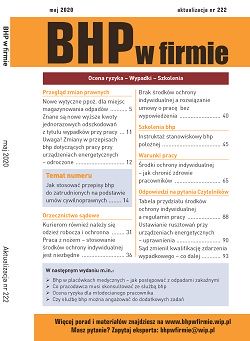
- Subject of the issue: How to apply health and safety regulations to employees based on civil law contracts
Employment of persons on the basis of civil law contracts means that the employing entity is not subject to a number of obligations arising from the provisions of labor law. Those employed under civil law contracts cannot enjoy such privileges, referred to as legal labor protection, which result from the provisions of the Labor Code. However, they have the right to safe and healthy working conditions. The scope of application of OSH provisions to employees based on civil law contracts is not as explicit as for employees. It is therefore worth knowing the necessary minimum in this matter - before ensuring the appropriate level of safety is verified by the inspector of the National Labor Inspectorate.
- Allocation of personal protective equipment versus work regulations
There is nothing in the provisions of the Labor Code about the obligation to place a table for the allocation of personal protective equipment, clothing or work footwear. Can such an assignment table be placed in the work regulations? Should a separate procedure be established or an internal regulation governing this issue operating alongside work regulations?
- Scaffolding setting for power equipment - qualifications
A new regulation on health and safety at work at power equipment, which is to enter into force in September this year. includes construction and painting works as auxiliary works on energy devices. In this case, does the team installing scaffolding on equipment covered by the scope of qualifications when operating these equipment must also have energy qualifications? In addition, the regulation mentions a person authorized to perform specific activities or maintenance works. Has the design also been provided with a specimen of such authorization, or can you specify the specimen yourself?
- Midwife's workplace safety training
A midwife is a qualified independent employee, whose main task is to care for a woman at every stage of her life. It is a very demanding job and involves a lot of contact with people. The multitude of hazards at this workplace forces the midwife to be presented as an employee, these threats and ways to avoid, minimize, and prevent them. What are these methods? Check in the training presented.
- The court changed the classification of the accident event - what's next
The court issued a judgment in which it changed the classification of an accident event. He ruled, inter alia, that the incident which was the subject of the proceedings was considered an accident at work and in this respect item 7 of the minutes was corrected. What should you do in this situation? What is the next procedure assuming that the employer does not intend to appeal? How should post-accident documentation be handled, should the post-accident protocol be improved?
- Protective masks - mandatory or voluntary
Does the coronovirus epidemic force the introduction - as an additional personal protective measure - of the compulsory use of disposable protective masks by all employees at all times during their work?
- New fire prevention guidelines for waste storage locations
On March 4, 2020, the Ordinance of the Minister of Interior and Administration of February 19, 2020 on fire protection requirements to be met by construction works or parts thereof and other places intended for collecting, storage or waste treatment. It contains new guidelines on how to organize these places. Due to the numerous obligations introduced by the new regulation, it is worth taking a moment to carefully read the new guidelines.
- New higher amounts of one-off compensation for accidents at work are known
From April 1, 2020, new amounts of one-off compensation for accidents at work or occupational diseases are in force. According to the announcement of the Minister of the Family, Labor and Social Policy of March 3, 2020 regarding the amount of one-time compensation for an accident at work or occupational disease (MP item 279), the amount of compensation for each percentage of permanent or long-lasting damage to health than before. Check new amounts.
- Toe amputation - classification of an accident
Should the injury of crushing the foot and a long stay in the hospital, which ended with amputation of the toes of the I-III to the proximal phalanges, be a serious accident?
BHP w firmie (Work safety in the company) - full list







